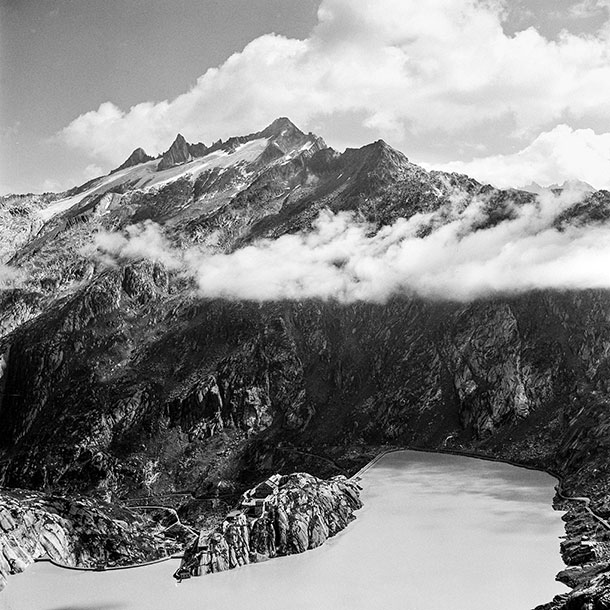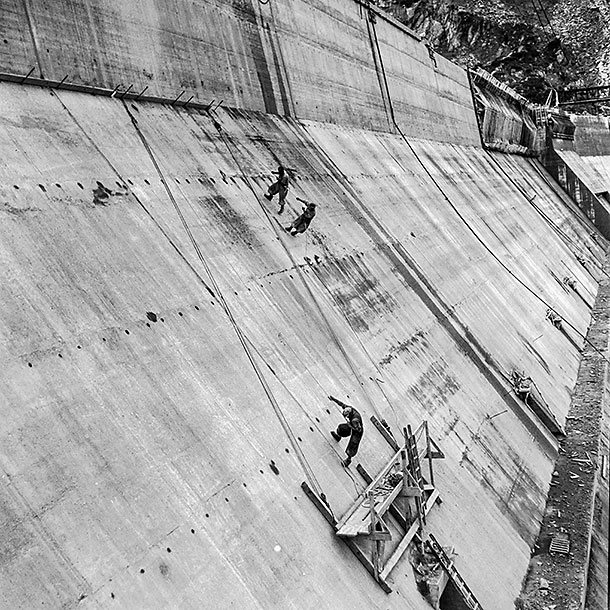A cultural history of Switzerland’s dams
Text: Samuel Schlaefli
Dams are more than just pioneering technical feats. For the valley dwellers who had to move when they were built, they are often associated with life-changing upheavals and the loss of home. The website verschwundene-taeler.ch that has been started up in Basel relates for the first time the cultural history of the construction of Switzerland’s dams.
A rust-colored millwheel, carefully prepared dry-stone walls, broken roof beams from derelict cowsheds: all of these came to light when the Lago di Lei, an artificial lake on the border between Italy and Graubünden, was drained for maintenance work in winter 2012. Fifty years earlier, more than a dozen mountain pastures had been flooded to make way for a reservoir and storage power station designed to produce Switzerland’s future electricity. Such remnants of a lost civilization can be found in many places around the country. They remind us of a life that existed prior to the construction of the dam – and that much more than concrete and steel went into creating these structures.
«I would find it extremely traumatic if someone told me that I had to leave my home village to make way for an industrial project», says Sabine Eggmann, an assistant lecturer and research associate at the Department for Cultural Studies and European Ethnology at Basel University. In recent years, she and her team have been making a detailed study of the building of hydroelectric power stations in Switzerland. The researchers chose to approach the subject from an actor-centered perspective. «Our main interest was not in the structures themselves, but in the people affected by their construction.»
The research project has given rise to a website, verschwundene-taeler.ch, which has been online since February this year. In nine chapters, it describes and compares 10 dam projects completed between 1920 and 1965, focusing particularly on the decision-makers at the time and the impacts on the people affected by the structures.
Inspired by photographs
It all started with the photographs of Ernst Brunner in the archives of the Swiss Society for Folk Traditions (SGV) in Basel. In the 1940s and 1950s, Brunner traveled around rural and Alpine Switzerland taking photographs of local people and the trades they were engaged in. Among them were the dam construction workers of Cleuson, in the Valais, and Grimsel, in Bern. The cultural studies specialist Pierrine Saini came across Brunner’s photographs when she was carrying out an in-depth study of the SGV’s picture and film archive for her dissertation. She had already photographed many dam walls and reservoirs herself and was fascinated by Brunner’s pictures. As a research associate for the web project, she embarked on a comprehensive trawl through the archives. Over four years, she put together a collection of radio reports, audiovisual documents, eye-witness reports, lists of compensation payments for those resettled, miners’ song lyrics, and photos of dam construction in Switzerland. Many of her discoveries are now available to a wider public for the first time via the website.
To seek out additional material, Saini also carried out her own fieldwork. For example, at Salanfe in the Valais – at nearly 2,000 meters above sea level – she took pictures of the reservoir, the dam, and the ruins of the flooded village, which are still visible. Via the local inn, she made contact with Nicolas Mettan, an authority on the history of the dam, who over the years has built up his own collection of historical documents and photographs on the subject. Mettan’s mother was one of the locals who used to spend every Alpine summer in the village that later had to make way for the artificial lake needed to generate electricity. Saini was able to ask her about her experiences. «She had painful memories of having to leave her old home. She talked about the years before the move in a nostalgic and slightly idealized way – even though life on the mountainside was difficult and impoverished.»
Rebellion in Andermatt
The people who had to give up their mountain pastures to make way for the dams were often poor farmers. Sometimes there were long negotiations about suitable replacement locations and the level of compensation payments. In these poor and indebted communities, there was generally little resistance to the planned dams. Many social scientists put this down to the fact that the social, cultural and economic capital needed for resistance was simply not present. The demands of the time were also a factor: «During the war, the major construction projects were an important contribution to the ‘spiritual defense of the nation’. They became part of a strong Swiss identity and a guarantor of a secure energy supply and autonomy», Saini explains. Many farmers even welcomed the new start. For them, the reservoirs and improved infrastructure opened up new sources of income, especially in tourism.
While most resettlements went ahead peacefully, there was a clear exception, which has gone down in history as the «Andermatt riot». The 2,000 inhabitants of Andermatt, in the Ursener valley in Uri, were to be resettled to make way for a lake six times larger than Lake Hallwil. On 19 February 1946, 300 locals chased the engineer working on the project, Karl Fetz, out of the village and smashed up the office of the architect in charge. After 30 years in the planning, the scheme was finally abandoned at the start of the 1950s.
Discourses of modernity
«The thing I find most fascinating about the subject is the interplay between subjective experiences and personal life stories, on the one hand, and the dominant social discourses of the time, on the other hand», explains Eggmann. She is convinced that the program of dam construction after the turn of the century would have been unthinkable without the craze for technology that accompanied the dawn of the modern age. The sacrifices made by the resettled population were required as a contribution to the electrification of the country, to progress, and to national unity – all the more so because dam construction formed part of a nationalist discourse, fueled by business, in support of an innovative, modern Switzerland with strong links to the outside world.
The website on Swiss dam construction remains a «work in progress.» New archival material and eye-witness reports are continually being added. Saini is also currently trying to organize funding for an app to enable people visiting the dams to relive their stories interactively, via their smartphones, at the same time – cultural studies 2.0 in place of «Pokémon Go», as it were.
More articles in the current issue of UNI NOVA.


